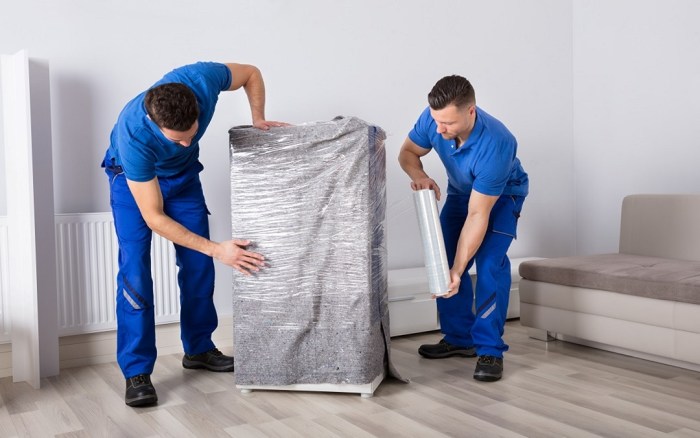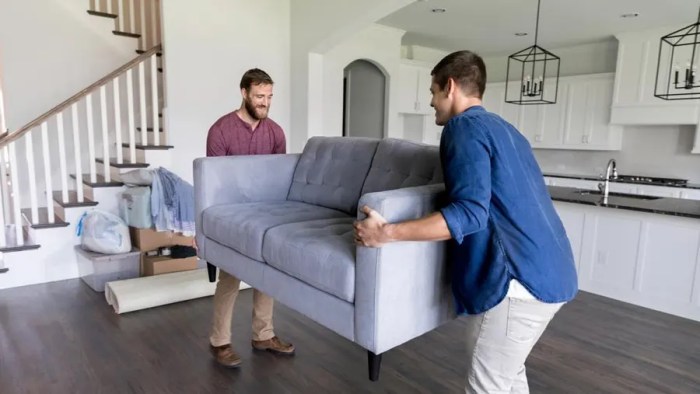In home furniture moving – As in-home furniture moving takes center stage, this opening passage beckons readers into a world crafted with knowledge, ensuring a reading experience that is both absorbing and distinctly original. In this comprehensive guide, we delve into the intricacies of furniture relocation, empowering you with the insights and techniques to navigate this task with ease and efficiency.
In-Home Furniture Moving Services

In-home furniture moving services offer a comprehensive range of solutions for moving furniture within your home. These services cater to various needs, from rearranging furniture to relocating items to different rooms or floors.
Types of In-Home Furniture Moving Services
- Furniture Rearranging:Involves moving furniture within the same room to create a new layout or accommodate new items.
- Furniture Relocation:Refers to moving furniture from one room to another, such as from a bedroom to a living room.
- Floor-to-Floor Moving:Entails moving furniture between different floors of a house, using stairs or elevators.
- Heavy Furniture Moving:Specializes in handling bulky and heavy furniture items, such as pianos, safes, and appliances.
- Specialized Furniture Moving:Provides services for moving delicate or valuable furniture items, such as antiques, artwork, or heirlooms.
Benefits of Using In-Home Furniture Moving Services
- Convenience:Professional movers handle the heavy lifting and transportation, saving you time and effort.
- Safety:Trained movers ensure safe handling of furniture, minimizing the risk of damage or injury.
- Efficiency:Movers use proper techniques and equipment to move furniture quickly and efficiently.
- Flexibility:Services can be tailored to meet your specific needs, including scheduling and time constraints.
Planning and Preparation for In-Home Furniture Moving

Before embarking on an in-home furniture move, thorough planning and preparation are crucial for a smooth and successful experience. This involves decluttering and organizing your belongings, as well as carefully packing and protecting your furniture.
Decluttering and Organizing, In home furniture moving
Decluttering your home prior to moving furniture not only reduces the amount of items you need to move, but also makes it easier to pack and transport. Sort through your belongings, discarding or donating anything you no longer need or use.
Organize the items you plan to keep into categories, such as clothing, books, and kitchenware, for easier packing.
Packing and Protecting Furniture
To ensure your furniture arrives at its new location in pristine condition, it’s essential to pack and protect it properly. Use high-quality packing materials such as bubble wrap, packing paper, and sturdy boxes. Disassemble furniture when possible to reduce its size and make it easier to handle.
Wrap individual pieces of furniture in protective materials and secure them with packing tape. Label boxes clearly to indicate their contents and which room they belong to.
| Item | Packing Tip |
|---|---|
| Upholstered Furniture | Wrap in plastic wrap and secure with tape. Cover with a moving blanket for added protection. |
| Glassware and Dishes | Wrap each item individually in bubble wrap or packing paper. Use sturdy boxes with dividers or compartments to prevent breakage. |
| Electronics | Remove batteries and cables. Wrap each item in anti-static wrap or bubble wrap. Use original packaging or sturdy boxes for protection. |
| Artwork and Paintings | Remove from frames and wrap in acid-free paper. Place in sturdy boxes with plenty of padding. |
Techniques for Moving Furniture Safely and Efficiently

Moving furniture can be a daunting task, but it can be done safely and efficiently with the proper techniques.To begin, it is important to assess the weight and size of the furniture you are moving. If the furniture is heavy, you will need to enlist the help of a friend or family member.
Once you have assessed the weight of the furniture, you can begin to lift it.When lifting furniture, it is important to use proper body mechanics. Bend your knees and lift with your legs, not your back. Keep your back straight and your head up.
Avoid twisting your body while lifting.If the furniture is too heavy to lift, you can use furniture sliders to move it. Furniture sliders are small, plastic discs that you place under the legs of the furniture. The sliders will allow you to slide the furniture across the floor without damaging it.Once
you have lifted the furniture, you need to move it through doorways, hallways, and stairs. When moving furniture through doorways, be sure to measure the width of the doorway and the height of the furniture. If the furniture is too wide or too tall to fit through the doorway, you will need to remove the doors or disassemble the furniture.When
moving furniture through hallways, be sure to clear a path and remove any obstacles. If the hallway is narrow, you may need to turn the furniture on its side to get it through.When moving furniture up or down stairs, be sure to use a hand truck or dolly.
This will help you to prevent injury and damage to the furniture.
Considerations for Special Furniture Items: In Home Furniture Moving
Moving delicate or valuable furniture requires special care and attention. Delicate furniture, such as antiques or glass-topped tables, can be easily damaged if not handled properly. Valuable furniture, such as family heirlooms or expensive artwork, should be packed and moved with the utmost care.
Large or oversized furniture, such as sofas, beds, and armoires, can be difficult to move. It is important to plan ahead and make sure you have the proper equipment and assistance to move these items safely.
In-home furniture moving can be a daunting task, but it doesn’t have to be. With the right tools and a little help from friends or family, you can get the job done quickly and easily. If you’re looking for high-quality furniture that will last for years to come, rana furniture is a great option.
They offer a wide variety of styles to choose from, so you’re sure to find something that fits your taste. Plus, their furniture is made from durable materials that will withstand the wear and tear of everyday life. Whether you’re moving furniture within your home or to a new location, rana furniture can help make the process easier.
Furniture with electronics or appliances attached, such as entertainment centers or refrigerators, should be disconnected and packed separately. This will help to prevent damage to the electronics or appliances during the move.
Preparing and Packing Delicate Furniture
Delicate furniture should be carefully wrapped in bubble wrap or packing paper. Use plenty of padding to protect the furniture from scratches and dents. If possible, disassemble the furniture into smaller pieces for easier handling.
Moving Large or Oversized Furniture
Large or oversized furniture should be moved with the help of a furniture dolly or hand truck. Make sure the furniture is securely strapped to the dolly or hand truck to prevent it from falling off during the move.
Moving furniture within your home can be a daunting task, especially if you have heavy or bulky items. If you need assistance, consider seeking furniture moving help from professionals. They can provide the necessary equipment and expertise to ensure a safe and efficient move.
Once your furniture is in place, remember to secure it properly to prevent accidents.
Moving Furniture with Electronics or Appliances Attached
Furniture with electronics or appliances attached should be disconnected and packed separately. This will help to prevent damage to the electronics or appliances during the move. Make sure to label all cords and wires so that you can easily reconnect them after the move.
Post-Move Furniture Arrangement and Assembly
After the arduous task of moving your furniture, it’s time to arrange and assemble it in your new abode. This step is crucial to create a comfortable and functional living space. Planning ahead and using proper techniques will ensure a seamless and efficient process.
In-home furniture moving can be a daunting task, especially if you’re unsure of how to handle the furniture properly. If you’re considering purchasing new furniture for your home, be sure to check out reviews for wayfair furniture to see what other customers have to say about their experiences.
Wayfair is a popular online retailer that offers a wide variety of furniture options, so you’re sure to find something that fits your style and needs. Once you’ve chosen the perfect furniture, be sure to follow the manufacturer’s instructions for moving and assembling it safely.
Before moving in your furniture, take some time to plan its arrangement. Consider the size and shape of the room, the natural flow of traffic, and the functionality you desire. A well-planned layout will maximize space utilization and enhance the overall aesthetics of your home.
Furniture Arrangement Techniques
Various furniture arrangement techniques can be employed to achieve different effects:
| Technique | Description | Benefits |
|---|---|---|
| Symmetrical | Furniture is arranged in a mirror-image fashion on both sides of a central axis. | Creates a formal and balanced look, suitable for traditional or classic interiors. |
| Asymmetrical | Furniture is arranged in an uneven or unbalanced manner. | Adds a touch of informality and visual interest, ideal for modern or contemporary spaces. |
| Radial | Furniture is arranged in a circular or semi-circular pattern around a focal point. | Creates a cozy and intimate atmosphere, suitable for living rooms or seating areas. |
| Conversational | Furniture is arranged to facilitate conversation and social interaction. | Enhances the functionality of living spaces and gathering areas. |
After arranging your furniture, it’s time to assemble any pieces that require it. Follow the manufacturer’s instructions carefully, and use the appropriate tools and materials. If you encounter any difficulties, don’t hesitate to seek professional assistance.
Safety Precautions for In-Home Furniture Moving
Moving furniture can be a physically demanding task that poses potential risks of accidents and injuries. Observing safety precautions is paramount to ensure a safe and efficient move.
Potential hazards include sharp edges, heavy weights, and slippery surfaces. Plan your moves carefully to avoid these hazards and prevent accidents.
Guidelines for Confined Spaces and Uneven Surfaces
When moving furniture in confined spaces, such as narrow hallways or staircases, take extra care to avoid bumping into walls or other objects. Use proper lifting techniques to prevent strains or falls.On uneven surfaces, such as stairs or slopes, always have a spotter to assist with balance and prevent slips.
Use non-slip mats or furniture sliders to reduce the risk of the furniture sliding or rolling unexpectedly.
Ultimate Conclusion
In conclusion, in-home furniture moving presents a unique set of challenges that can be overcome with proper planning, preparation, and execution. By embracing the guidance Artikeld in this comprehensive guide, you can transform your furniture relocation into a seamless and stress-free endeavor.
Remember, with careful consideration and a touch of ingenuity, you can master the art of in-home furniture moving, ensuring a smooth transition into your new abode.
Answers to Common Questions
What are the benefits of using in-home furniture moving services?
In-home furniture moving services offer numerous advantages, including professional handling, time savings, damage prevention, and convenience.
How should I prepare my furniture for an in-home move?
Proper preparation involves decluttering, organizing, and carefully packing your furniture using appropriate materials to ensure its protection during transit.
What techniques can I use to move furniture safely and efficiently?
Employ proper lifting techniques, utilize furniture sliders or dollies, and plan your moving route to minimize obstacles and ensure a smooth relocation.